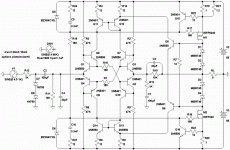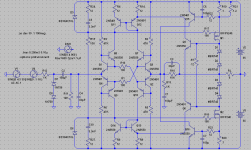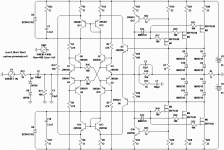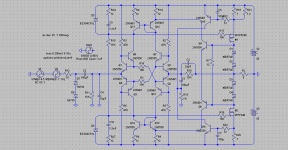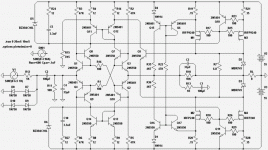Hey Ken, could you achieve less barbaric clipping by changing Q15's collector over to the left side of R10? This way, the VAS won't dump current into the limit transistors.
- keantoken
- keantoken
Highlee interessant... But what effect does that have upon offset?
As long as it don't leak any DC, I suppose its OK. Is that realistic?
That clip is for safety, current limiting. Yet the barbaric side effect,
feedback related transistors are shut off by it. Tricking the NFB loop
to do this dirty work is preferable in that respect over shorting drive
to the rail. I think I would still leave the Barbaric Zenier in there...
Berberis is sour berries you put on rice.
Whatever, shouldn't current clipping have a higher threshold into
8ohms than input voltage clipping? I guess this isn't hard to adjust...
Throw another Schottky to the drive, just so's if the loop don't
succeed in stopping the overcurrent, the protection circuit can
still function as was originally intended. And there needs to be
resistors too, so's BOTH limits are still able to activate at once.
The way you got it now, can have an infinate output current
into a shorted load, so long as the DCs balance... Supposin
the Schottky stack was to overheat? Even though thats not
real likely... I like not to sabotage my insurance.
As long as it don't leak any DC, I suppose its OK. Is that realistic?
That clip is for safety, current limiting. Yet the barbaric side effect,
feedback related transistors are shut off by it. Tricking the NFB loop
to do this dirty work is preferable in that respect over shorting drive
to the rail. I think I would still leave the Barbaric Zenier in there...
Berberis is sour berries you put on rice.
Whatever, shouldn't current clipping have a higher threshold into
8ohms than input voltage clipping? I guess this isn't hard to adjust...
Throw another Schottky to the drive, just so's if the loop don't
succeed in stopping the overcurrent, the protection circuit can
still function as was originally intended. And there needs to be
resistors too, so's BOTH limits are still able to activate at once.
The way you got it now, can have an infinate output current
into a shorted load, so long as the DCs balance... Supposin
the Schottky stack was to overheat? Even though thats not
real likely... I like not to sabotage my insurance.
Last edited:
One member here says that speaker loads normally can be as much as 1/3 impedance at certain times. So current limiting I guess should be adjusted higher even though a purely resistive load wouldn't draw so much current.
You could put caps across the B-E's of Q15 and Q16 to extend current drive within SOA limits.
Also, why not try buffering the MOSFETs with EF's? I wonder if this affects stability. As it is, the gate drive to the MOSFETs only sees low AC impedance. DC impedance here is practically zero. Adding at east some small DC impedance with an EF might be beneficial.
- keantoken
You could put caps across the B-E's of Q15 and Q16 to extend current drive within SOA limits.
Also, why not try buffering the MOSFETs with EF's? I wonder if this affects stability. As it is, the gate drive to the MOSFETs only sees low AC impedance. DC impedance here is practically zero. Adding at east some small DC impedance with an EF might be beneficial.
- keantoken
Didn't think my crazy current drive was all that broke.
Why we throwin another whole EF stage at fixin' it?
Already handles the full swing @96K, we need more?
I ain't fond of mixing caps and clipping, sounds like a
strategy for error storage and delayed recovery? Show
me the plan when you got something direct coupled.
Why we throwin another whole EF stage at fixin' it?
Already handles the full swing @96K, we need more?
I ain't fond of mixing caps and clipping, sounds like a
strategy for error storage and delayed recovery? Show
me the plan when you got something direct coupled.
Last edited:
The caps I describe would, infact, cause current limit only on bass and low frequencies (too low frequency for SOA), which actually supports your idea of a "preserved clip" where only the troublesome noises are clipped (the cap would cause clipping of the bass but wouldn't clip others). I don't have much experience with this charge storage stuff you're always talking about, so maybe I'm missing something. My understanding is that although a cap would store energy, it actually extends the dynamic range where extendable rather than a direct coupled clipper that would clip out things other along with the troublesome signals. The cap extends power output, and in no way detracts from it, albeit behavior is the same at the low end of the frequency spectrum. Unless of course, we overdrive the Q15/16 and run into a diode type effect, but I don't see how this would happen in reasonable operation.
Got to sleep now. Cya
- keantoken
Got to sleep now. Cya
- keantoken
the cap would cause clipping of the bass but wouldn't clip others
When bass clips, every frequency above is obliterated for the duration.
I'm not sure how you would suggest the cap has prevented this effect
from mutilating smaller signals at higher frequencies?
If you wish to selectively current clip subsonic bass that shouldn't be
in normal program material to begin with, that might be an acceptable
compromise. Still have to watch SOA isn't violated in either the short
or long term. I'm not sure why I would want a higher current limit at
higher frequencies? Tweeters just don't eat that much current...
Notice that the collectors of Q15 and Q16 act as CCS's when driven into clipping. Thus they can't actively distort the amp unless driven by an AC signal at their Vbe. Putting a cap across this Vbe bypasses clipping protection for frequencies above a certain point, because the transistor no longer responds to them. Thus, only low enough frequencies will be clipped. If we forget the cap, Q15/16 will respond to all frequencies, and clip midrange and highs when only the lows are acting up. This is for current limit clipping, not voltage.
- keantoken
- keantoken
Agh... You still don't get it? I thought it all clear as mud?Thus, only low enough frequencies will be clipped.
Clipping. Any contortion of a wave that results in it doing something
totally arbitrary and unrelated to the signal, nor any smaller signals
that might simultaneously have been present for the duration of the
offence. Music rarely consists of a single sinewave acting on its own...
To include:
Flat against either rail. Flat against either slew.
Sticking to rail, slew, tail, or ringing waveform after a transient.
Crossing distortion, if any spot of the middle is flat, sticky, ringing,
or or slew rate limited. The amp is doing something else entirely
unrelated (not a reversible distortion) of the signal it should be
passing.
Its all EXACTLY the same thing. The smaller waves are obliterated for
the entire duration of the larger wave's offense. We can extend this
to include any misbehavior that causes is an irreversible transform, or
tosses out information. Thus all MP3's are clipping too. Wait, what???
Nonlinear distortions and dynamic compressions that retain all the
information that could be restored if one went to enough trouble...
These distortions are not clipping, at least not hard clipping.
-------------
When bass clips, EVERYTHING else present clips with it... No exception.
Unless you are willing to separate offending frequencies before clipping,
run each through its own MI amp, and then reassemble afterward... I
think thats just a chore not well performed in the purely analog realm.
Certainly a capacitor isn't going to do this. Not even paper in snakeoil!
Last edited:
Relies upon most of the amp working to prevent a disaster
caused by a failed chain of events in that same amp???
I'm not sayin it ain't the more graceful clipper (sans cap),
just that it doesn't protect as many modes of meltdown.
I remind you: In the event of thermal runaway, both can
have equal pull on the feedback to no effect whatsoever.
And the feedback loop makes this balance a likely event.
In my latest version I have parallel MOSFETs, so plenty of
opportunity to graft the old barbaric current limiter to one
of the alternate and otherwise unwatched source resistors.
caused by a failed chain of events in that same amp???
I'm not sayin it ain't the more graceful clipper (sans cap),
just that it doesn't protect as many modes of meltdown.
I remind you: In the event of thermal runaway, both can
have equal pull on the feedback to no effect whatsoever.
And the feedback loop makes this balance a likely event.
In my latest version I have parallel MOSFETs, so plenty of
opportunity to graft the old barbaric current limiter to one
of the alternate and otherwise unwatched source resistors.
Last edited:
Re #522:
Remind me again why I want to store a long duration response to a short
duration problem on a 100uF cap bled by 1K thats also my one and only
DC servo reference for this whole amp?
From collector I got 10K in series to the feedback node. And a Schotkky
to the drive, just incase the loop has failed. Won't need that diode if
Barbaric limit is handled from a separate and parallel drain watcher...
VBE and HFE difference in Q15 Q16 is a nuisance... Focus on that for a
minute. Maybe its just VBE...
Remind me again why I want to store a long duration response to a short
duration problem on a 100uF cap bled by 1K thats also my one and only
DC servo reference for this whole amp?
From collector I got 10K in series to the feedback node. And a Schotkky
to the drive, just incase the loop has failed. Won't need that diode if
Barbaric limit is handled from a separate and parallel drain watcher...
VBE and HFE difference in Q15 Q16 is a nuisance... Focus on that for a
minute. Maybe its just VBE...
Last edited:
If all else fails...
Attachments
Last edited:
The schottkeys you used have 740pF of capacitance, I fear they may corrupt the signal path. I suggest to use a silicon or a smaller schottkey.
I didn't see the concern for DC offset with the #552 before. Imbalance of Q15 and Q16 could cause the DC offset to drift during clipping. It looks like we can scratch that one off. Try this.
I grabbed a handful of vitamins yesterday, I think my brain is in gear lately. Gotta figure out how those work...
- keantoken
I didn't see the concern for DC offset with the #552 before. Imbalance of Q15 and Q16 could cause the DC offset to drift during clipping. It looks like we can scratch that one off. Try this.
I grabbed a handful of vitamins yesterday, I think my brain is in gear lately. Gotta figure out how those work...
- keantoken
Attachments
Then I'd just put a barbarian drain watcher on another drain and ditch teh Schottky.
Hey, notice I moved R15??? Effect is negligible, mo pointless symmetry for what?
Pretty picture? I shoulda left it unbalanced, just to make peeps ask the question.
Hey, notice I moved R15??? Effect is negligible, mo pointless symmetry for what?
Pretty picture? I shoulda left it unbalanced, just to make peeps ask the question.
Last edited:
I'm happy now with how the output soft and hard current limits.
Try dropping the load down 4 ohms or less, see how it shapes.
I had a beast of a time getting Q15 Q16 reliably biased to always
have the same threshold, I'm not sure this is the simplest way it
could have been done.
I'm not entirely pleased with the soft voltage limiting at the input.
Kicks in too early, and doesn't knee hard enough to stop a really
big input signal from eventually causing much uglier true clipping
that can shut off transistors and/or store error. It don't exactly
recover from a real clip the cleanest way you could hope for.
I managed to Muntz out half the parts in the Schottky stack at
the cost of loss of full symmetry, and a slight increase in 1W H2.
But the output voltage swing can travel quite a bit further now!
Q5's collector can actually get into trouble on high enough swing,
largely the reason for the poor clip recovery I mentioned above.
Still a work in progress, but you can see my design philosophy:
Smooth out and/or prevent every other possible misbehavior you
might actually hear (or smell burning) , and nitpick about sub-
percentile harmonic distortion for small signals last.
Try dropping the load down 4 ohms or less, see how it shapes.
I had a beast of a time getting Q15 Q16 reliably biased to always
have the same threshold, I'm not sure this is the simplest way it
could have been done.
I'm not entirely pleased with the soft voltage limiting at the input.
Kicks in too early, and doesn't knee hard enough to stop a really
big input signal from eventually causing much uglier true clipping
that can shut off transistors and/or store error. It don't exactly
recover from a real clip the cleanest way you could hope for.
I managed to Muntz out half the parts in the Schottky stack at
the cost of loss of full symmetry, and a slight increase in 1W H2.
But the output voltage swing can travel quite a bit further now!
Q5's collector can actually get into trouble on high enough swing,
largely the reason for the poor clip recovery I mentioned above.
Still a work in progress, but you can see my design philosophy:
Smooth out and/or prevent every other possible misbehavior you
might actually hear (or smell burning) , and nitpick about sub-
percentile harmonic distortion for small signals last.
Attachments
Last edited:
That looks nice, it looks like the beginnings of an amp project. Still holding out on the clipper caps?
The one-transistor Allison theoretically should have less distortion than the dual, since it has twice the transconductance. Don't know with what compromises though. Ultra distortion is overrated though, and a little H2 is probably beneficial to a circuit that is naturally 3rd dominant.
- keantoken
The one-transistor Allison theoretically should have less distortion than the dual, since it has twice the transconductance. Don't know with what compromises though. Ultra distortion is overrated though, and a little H2 is probably beneficial to a circuit that is naturally 3rd dominant.
- keantoken
Well, I'm not deliberately trying to distort any signal under 45V and 6A.
Yet soft voltage and current limiting knees probably shouldn't have too
abrupt an onset. Hard to say exactly where they have to begin? Might
be something that has to be tuned by ear after the fact. Perhaps there
should be front panel controls for it?
Not exactly the same distortion controls as one might expect for an MI
amplifier... Especially not the current limiting... Then again, something
to be said for the Ron Popeil approach, "Set it and forget it."
Yet soft voltage and current limiting knees probably shouldn't have too
abrupt an onset. Hard to say exactly where they have to begin? Might
be something that has to be tuned by ear after the fact. Perhaps there
should be front panel controls for it?
Not exactly the same distortion controls as one might expect for an MI
amplifier... Especially not the current limiting... Then again, something
to be said for the Ron Popeil approach, "Set it and forget it."
Last edited:
- Home
- Amplifiers
- Solid State
- Simulation Analysis of several unique Allison-based output stages.
